

What is Culture Hacking? Cultural hacking is quite new in terms of HR methodologies and techniques, and from an early adopter standpoint, it’s is probably leveraged more by fast growing startups and brand focused organizations that believe that their culture is living and breathing, not something that you work on once a year, after your annual employee engagement survey.
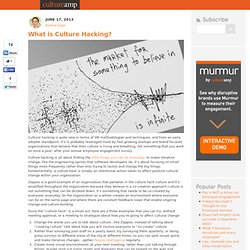
Culture hacking is all about finding the little things you can do everyday, to make iterative change, like the engineering sprints that software developers do, it’s about focusing on small things more frequently rather than only trying to tackle and change the big things. Fundamentally, a culture hack is simply an intentional action taken to affect positive cultural change within your organization. Can A Corporate Culture Be Built With Digital Tools? A whopping 20% of the world's workforce telecommutes: virtually traveling to work via robot or iPad; conversing on Yammer, HipChat, or 37Signals' Campfire; sharing over Box or Dropbox.
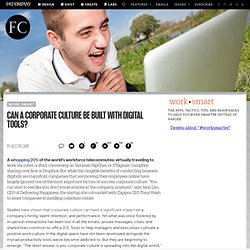
But while the tangible benefits of conducting business digitally are manyfold, companies that are moving their employees online have largely ignored one of the most important factors of success: corporate culture. "You can start to feel like you don't know anyone at the company anymore," says Jenn Lim, CEO of Delivering Happiness, the startup she cofounded with Zappos CEO Tony Hsieh to assist companies in instilling corporate values. Studies have shown that corporate culture can have a significant impact on a company's hiring, talent retention, and performance.
Yet what was once fostered by in-person interactions has been lost in all the emails, private messages, chats, and shared links common to office 2.0. Not everyone believes that businesses need specialized badges to foster culture online. Getting to Effective Social Business Results: Applying Culture Change. Let’s face it.
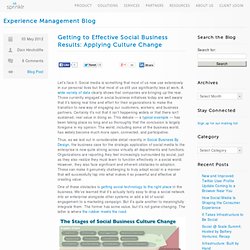
Social media is something that most of us now use extensively in our personal lives but that most of us still use significantly less at work. A wide variety of data clearly shows that companies are bringing up the rear. Emotional Contagion Can Take Down Your Whole Team - Tony Schwartz. Workplaces as Communities. Metaphors are great.
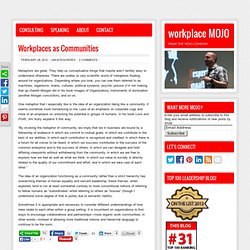
They help us conceptualize things that maybe aren’t terribly easy to understand otherwise. There are oodles (a very scientific word) of metaphors floating around for organizations. Depending where you look, you can see them referred to as machines, organisms, brains, cultures, political systems, psychic prisons (I’m not making that up–Gareth Morgan did in his book Images of Organization), instruments of domination (another Morgan concoction), and so on. One metaphor that I especially like is the idea of an organization being like a community. Workplace Mojo. If you’re looking for a stuffy speaker or consultant who wears his tie entirely too tight and takes himself entirely too seriously, then I’m not your guy.
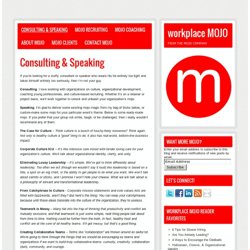
My passion is organizational culture, development, and leadership. . How You Can Improve Your Organization's Culture. Today’s guest post is by Darcy Eikenberg, author of Bring Your Superpowers to Work (get your copy HERE).
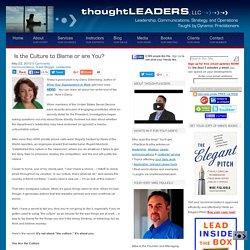
You can learn all about her at the end of the post. Here’s Darcy: When members of the United States Secret Service were recently accused of engaging prostitutes while on security detail for the President, investigators began asking questions not only about those directly involved but also about whether the department’s leadership may have endorsed (or ignored) a macho, untouchable culture. How to Engage Your Customers and Employees - R “Ray” Wang. Most customers now ignore targeted marketing campaigns, avoid responding to offers, and provide minimal feedback when asked.
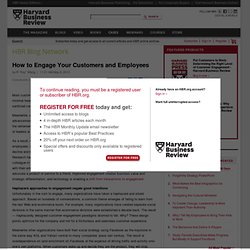
Instead, potential customers interact with each other, bypassing sanitized corporate messages devoid of meaning or value. Meanwhile, employees increasingly look beyond compensation to non-monetary factors such as advancement, recognition, and corporate social responsibility in choosing where to work. And with the retirement of the Baby Boomers looming, attracting, retaining, and growing the next generation of leaders is an essential task for any organization. CX Journey: Employee Experience Lifecycle.
CX Journey: Key Components of a VOC/CX Initiative - Part 4. This is the fourth post in a five-part series about the key components of a CX framework.

Engaged Employees The fourth component of the CX framework is the employee. Employees cannot be forgotten, as they are a crucial part of the success of your CX transformation and this new customer-centric culture! Remember that the employee experience drives the customer experience; if your employees aren't engaged, it will be very difficult for them to delight your customers; in very simple terms, this describes "the spillover effect. " Culture Takes Over When the CEO Leaves the Room - Frances Frei and Anne Morriss. By Frances Frei and Anne Morriss | 1:36 PM May 10, 2012 Here’s a rough summary of our worldview: excellence = design x culture.

Your job as a leader is to get both right. You must build a winning structure for your organization and then foster the often unspoken rules and values that will bring that structure to life. People tend to gravitate towards the design challenge, which includes things like strategy, business models, and incentive systems. Leverage the Millennial Mentality. Businesses can reshape their future by adapting the workplace to attract and retain workers from the millennial generation.
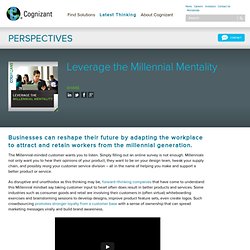
Millennial workers encourage innovation and collaboration in ways that can challenge traditional workplaces. But enterprises that actively engage this generation report greater productivity and new approaches to overcoming business challenges. The Millennial-minded customer wants you to listen. Simply filling out an online survey is not enough. What Student Blogs Say About Corporate Culture At Twitter, Intel, IBM, And Google.
On-campus recruitment is a highly competitive process, and success reeling in students with hat-size GPAs and pristine resumes can depend on a brand's ranking and reputation. As the summer winds down, you'll likely begin seeing much more of an oft-used recruitment tool: the corporate blog post written by a summer intern. They've already started to pop up all over--the so-called "diary of an intern," in which a young recruit must carefully walk the fine line of describing their experience in a "fun" and "challenging" light, while not coming off as too much of a company shill.
And of course, the intern blog has the potential to lure in or scare off future talent. Ideas Change Culture or Culture Changes Ideas. There’s an interesting aphorism I’d like to explore today, highlighted in the article title. Ideas change your culture or culture changes your ideas. Malouie: Are you a Thought Leader o... When Choosing a Job, Culture Matters - Bill Barnett. By Bill Barnett | 4:08 PM May 2, 2012. Unlocking Passion through Enterprise Social Networks. By Parsa Rohani, CEO, Neudesic Providing a platform to give your people a stronger voice will ignite their passion for their work. All good business leaders know that the right people are their most valuable asset. A leader’s primary objective should be to empower people to achieve their full potential and enable them to share their knowledge to better accelerate business objectives.
Creating a compelling, open and rewarding atmosphere of collaboration and knowledge sharing is one of the most important responsibilities of a business leader. Beyond establishing a culture of openness, organizations need enabling tools that support key business objectives. Implemented properly, open culture and collaboration software can combine to create a social fabric that sparks new passion and increases innovation among the people in an organization. Team roles – Innovator, motivator and networker. Tech's Top 10. When You Ignore Culture, You Get Employees Resigning in the NY Times. Creatively intelligent companies and leaders: Arts-based learning for business.
Employee Engagement Seen As Problematic, Study Says. Why Companies Fail - Magazine. Five Reasons The Term "Employee Engagement" Makes Me Feel Disengaged. 1- Employee engagement has become a buzzword with no meaning in some workplace. Goldman Sachs employee on culture. Orchestrating Collaboration at Work: Excerpt from Chapter 2. Social vs. Financial Exchanges. World Business Forum 2012. The power of the crowd has been a fundamental building block of the new economy.
Open source sharing and communication is accelerating the pace of innovation in nearly every field. Taking People With You - David Novak. Negotiating Innovation and Control - Scott Anthony. By Scott Anthony | 2:12 PM February 15, 2012. (5) CULTure - Life at Achievers.